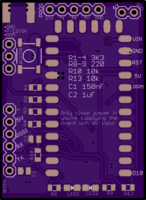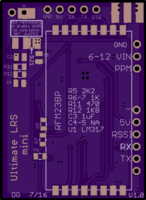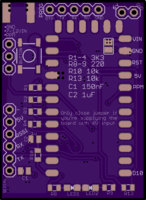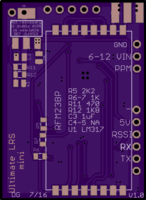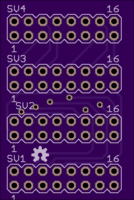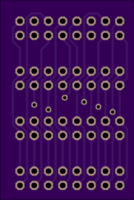
OSH Park
Shared projects
Ultimate LRS_Mini v1.01
by
2
layer board of
1.20x1.64
inches
(30.43x41.63
mm).
Shared on
July 10th, 2016 20:34.
v1.01 (this board supersedes v1.0)
NEW FOR VERSION 1:
-Improved silkscreen and labeling!
-Improved .sch!
-All silk readable w/o magnification!
-I’m still using a 4x4SMD tact button but now nearly any switch you can find will work with a little solder mask scraping!
-Provisions for >3S battery input!
If you want to run over 3S you have a new option- dont put the LM317 and it’s associated components on the board, instead use a UBEC (such as a Poloulu) and supply the board with 6V direct at the 2-pin input (upper right corner opposite antenna) and close the solder jumper on the right two legs of the LM317 (SJ1), when you do this STOP APPLYING POWER ON THE VIN PIN! DONT FORGET THIS STEP, YOU MUST REMOVE POWER INPUT FROM THE SIG/VIN/GND CONNECTOR! This will run the entire board (including arduino & Hope RF module) at 6v from any voltage your chosen UBEC can accept. (If you dont close the jumper the arduino will continue to receive it’s RAW power from the main source then you can use your own voltage supply for the Hope RF module, effectively making it run at any power level you wish. This also makes it easier for people who dont want to source LM317’s and have other LDO’s laying around). This method provides easy provisions for two groups of users, those wanting to independently supply the voltage to the Hope RF modue (either cause they have another type of Vreg and dont want to buy LM317’s or maybe because they want to adjust the power output on demand), it will also provide a easy way to run it on higher voltage systems (the reason I needed it)
All 0805 size components (including LEDs). All component values are marked on the silkscreen except for C4 and C5, please decide if you want to use them and choose appropriate values based off the datasheet
Project links:
ATTN: You MUST file / sand the edges of the Arduino mini down so they essentially become board edge vias. Dont worry, this process is very simple and makes very clean looking edge connections that are very easy to solder with very minimal work. Quickly sand / file the board edges down about 2/5 of the way threw the vias.
Note In the project thread on RCGroups I have pictured of built boards I’ve completed using a very strange Arduino Pro Mini clone with a double row of pins at the bottom for SPI and A4-A7, please DO NOT BE CONCERNED that you cant find that specific arduino clone, the pins needed for Ultimate LRS mini are all 1-to-1 compatible with the standard Arduino Pro-Mini and all it’s exact clones. Pretty much any 328p mini board you find will work and ULRS is using the most common pins that are [even on boards with slight differences] always in the same spot!!
ULRS_Mini_CK v1.0
by
2
layer board of
1.20x1.64
inches
(30.43x41.63
mm).
Shared on
July 10th, 2016 19:49.
v1.0 (this board supersedes by v1.01. please click link to be taken there
https://oshpark.com/shared_projects/2nCtZIbE
adapter-16bits
by
2
layer board of
0.94x1.40
inches
(23.83x35.56
mm).
Shared on
July 10th, 2016 15:29.
corrects pinout on 16-pin headers
iPhone Battery Charger v2.2
by
2
layer board of
3.24x1.26
inches
(82.40x31.90
mm).
Shared on
July 10th, 2016 14:56.
iPhone Battery Charger v2.2
This board is design to charge an iPhone 4, 4S, 5, 5S, 5C, 6, 6+ battery. The battery connectors are on separated sub-boards and only one can be connected to the main charging board at a time. Use 2.54mm male pins on the battery boards and a female socket on the main charging board. The battery boards are missing one pin to make the board ‘keyed’ so it can only plug in to the main board in one direction; this pin must be removed from the battery board header and it is recommended to add a plug to the female header on the main board.
The ‘Host Controller’ header allows connecting the charge board to a microcontroller for testing batteries. The iPhone batteries use TI Fuel gauge IC’s and communicate using the HDQ protocol. I have an example Arduino sketch that can be used to display some basic battery stats from the fuel gauge IC (GAS pin). The PROG and STAT pins are connected to the MCP73831 pins. For more info on these pins see the MCP73831 datasheet.
| RefDes | Component | Part # |
|---|---|---|
| C1 | 4.7uF 6.3V 0603 | - |
| C2 | 4.7uF 6.3V 0603 | - |
| F1 | 32VDC 2A Fuse 0603 | - |
| R1 | 1K ohm 0603 | - |
| R2 | 2K ohm 0603 | - |
| R3 | 1K ohm 0603 | - |
| U1 | MCP73831 SOT23-5 | MCP73831T-2DCI/OT |
| LEDCHGD | Green 0603 | - |
| LEDCHG | Orange 0603 | - |
| USB1 | FCI MicroUsb | 10118194-0001LF |
| Headers | 2.54mm / 0.1" | - |
| Header Plug (1) | - | 15-04-0292 |
| iPhone Conns | - | eBay |
IN-12 Nixie Driver
by
2
layer board of
1.46x3.21
inches
(36.98x81.43
mm).
Shared on
July 10th, 2016 13:02.
Driver circuit for IN-12 Nixie tube and K155ID1
